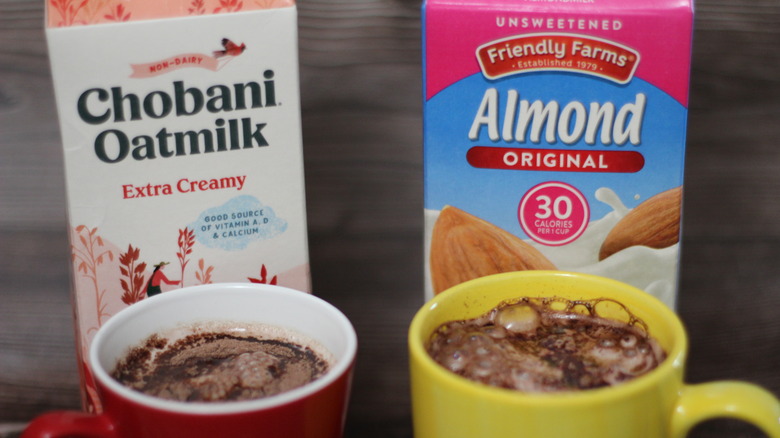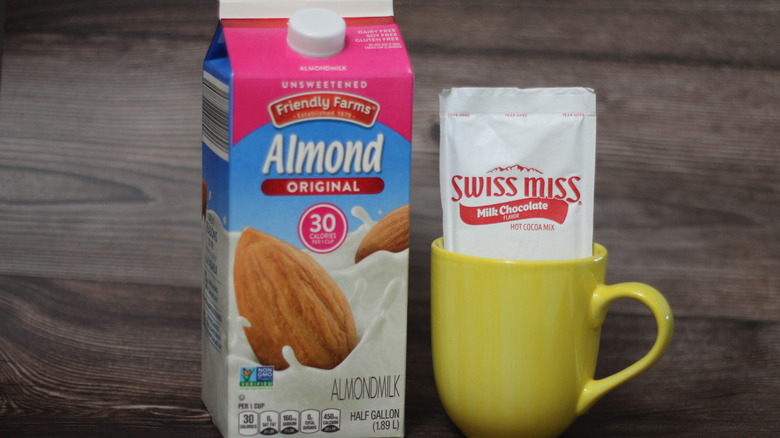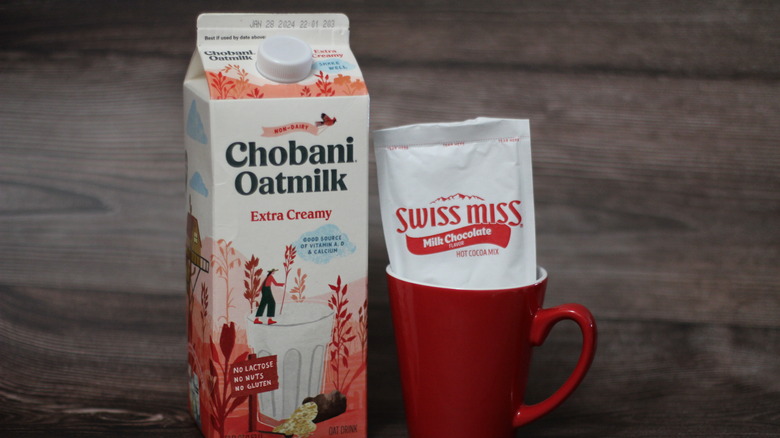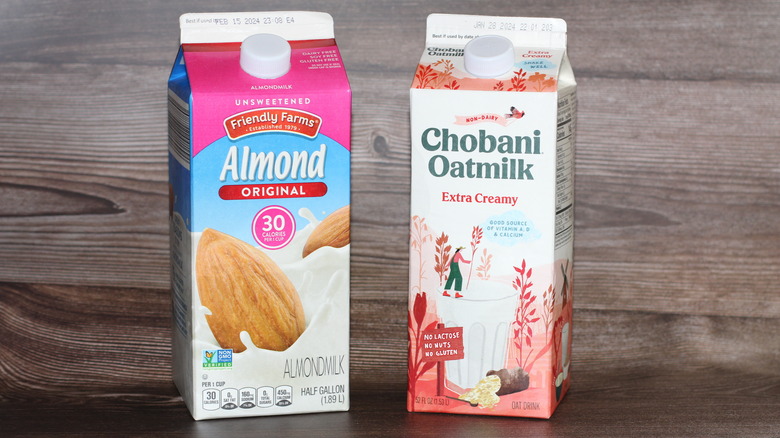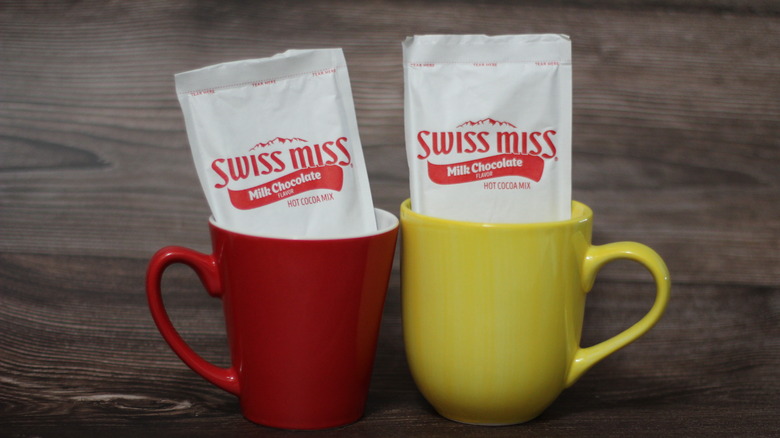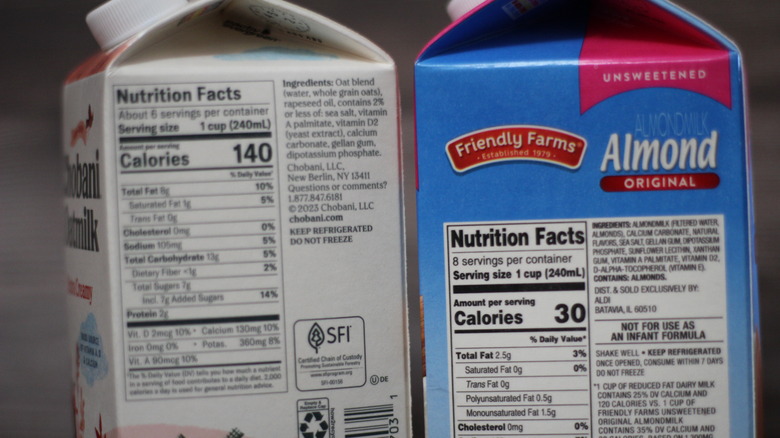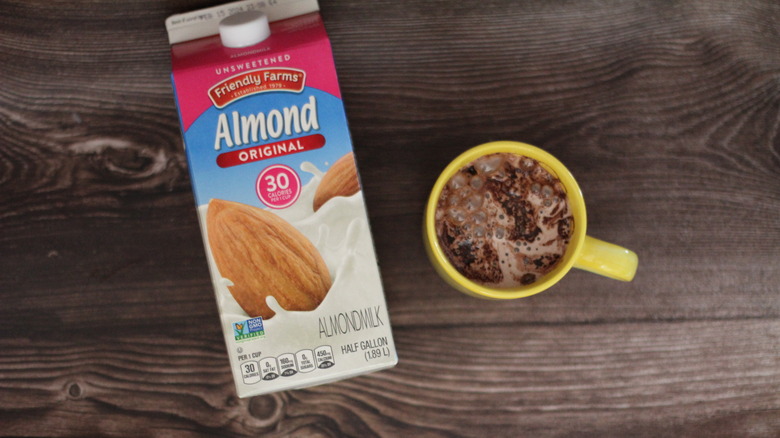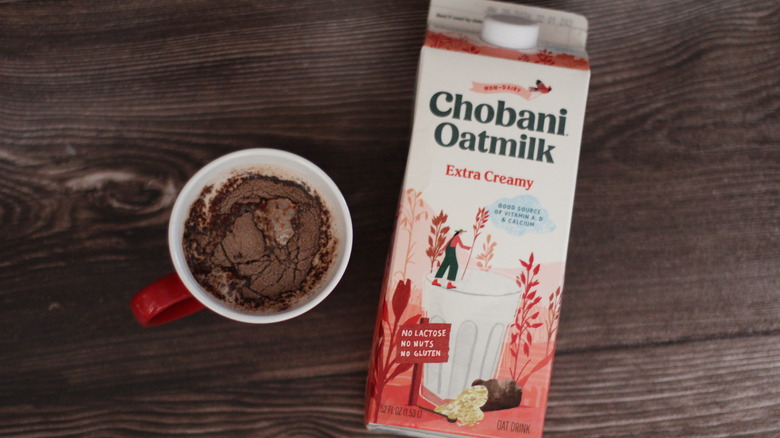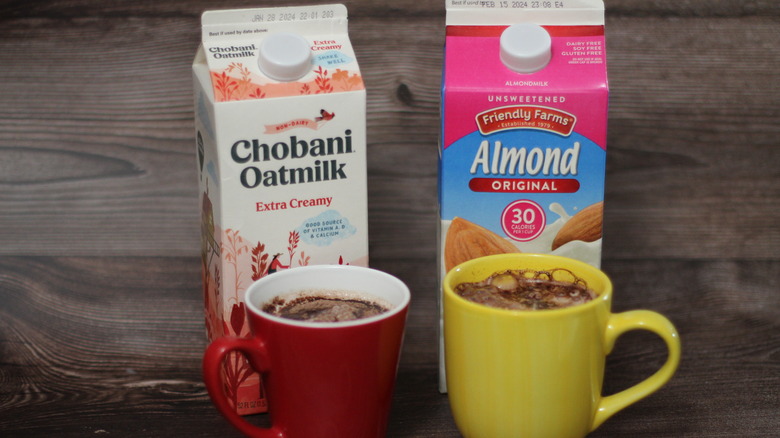Almond Vs Oat: Which Vegan Milk Makes The Better Cup Of Hot Chocolate?
Hot chocolate is a beverage we flock to on cold, blustery winter nights or when we need a noncaffeinated pick-me-up during our mid-day activities. There are sweet traditions of drinking this tasty treat around the world, starting with the Mayans, who were some of the first societies to ground the sacred cocoa into a beverage that could be used for celebrations, ceremonies, and the same situations where we would also raise a mug of hot chocolate. But these early civilizations probably never considered the conundrum of what the best non-dairy milk was to use for hot chocolate. Unless, of course, you'd consider water suitable for hot chocolate — which we don't.
There is a plethora of different non-dairy beverages out there, from pea milk to hemp milk, that can be used as a base for hot cocoa. We sampled two of the most popular dairy-free milks, almond and oat, to decide which made a better cup of hot chocolate at home. As plant-based eaters (for the most part), this test piqued our interest. We're always in search of delicious beverages, and finding hot cocoa with a mouthfeel similar to that of whole milk was the dream.
Almond milk separates at higher temperatures
We admit that almond milk has been our go-to non-dairy milk for as long as we can remember. The taste is relatively neutral and the texture is thin, which means we can use it for a lot of different purposes in our kitchen. However, the issue with almond milk is that the beverage is not a fan of being heated to high temperatures. Anyone who has made a latte at home with almond milk has probably experienced the thin film that always rises to the top of the mug or the small flecks that become interspersed in the beverage. This curdling happens for several reasons, one of which is that the heat breaks down the emulsion in the liquid. Acidic ingredients can accelerate this phenomenon and occur more readily in older almond milk rather than one that has been freshly pressed.
Besides using fresh almond milk and heating the product gradually, home baristas can utilize a "barista blend" or "heat-stable" product that is made to prevent curdling. You can also look for products made with whole almonds rather than powder or extracts to ensure that you're buying a quality product.
Oat milk has a creamier, smoother consistency
Oat milk has been touted as one of the most revolutionary vegan products because it has a relatively plain taste and creamy mouthfeel, making for a drinking experience similar to cow's milk. In addition, many folks claimed that oat milk has a sweeter flavor when it's steamed, which is prime for cappuccinos, lattes, and hot chocolate. This is thanks to the addition of enzymes into the oat milk that expedite the breakdown of carbohydrates and make for a smoother texture.
In addition, environmental activists have backed their support over oat milk rather than almond milk because oats take significantly less water to grow than almonds, which is especially relevant considering the water-strapped regions that dominate domestic almond production. While you may not factor in environmental footprint when grabbing a ½ gallon of almond milk in the grocery store's refrigerator section, it is an important factor for some eco-conscious shoppers.
The products we chose
Our product selection for this hot chocolate experiment was simple — since we already had containers of almond milk and oat milk left in our refrigerator from holiday baking and cooking. We chose the unsweetened, plain almond milk from Aldi's to compare to the Extra Creamy Oatmilk from Chobani. The Aldi's Friendly Farms Almond Milk was the thriftier find at $2.55 per ½ gallon, which is especially impressive considering that a container of the Silk almond milk from our local Target was priced at $3.29 for the same size.
The Chobani Extra Creamy Oatmilk was priced significantly higher than both the Aldi's and the Silk products at $4.29 at Target. This price gap was significant and one of the reasons we often don't buy oat milk from the store. Oat milk is so expensive because the oats are starchier and require more emulsifiers to break them down. Plus, there are numerous additives, gums, and oils added to the oat milk to give it a creamier mouthfeel. All of these products drive up the price and other pertinent issues like supply and labor.
Sourcing hot chocolate powder
We can't have hot chocolate without hot chocolate powder. We chose to use Swiss Miss Milk Chocolate powder for this recipe because it was readily available in our pantry and was already pre-portioned into specific amounts. This would ensure that we would get the same amount of powder in each cup without worrying about getting our powder measurement exact. Moreover, Swiss Miss is one of the most reputable brands in the hot cocoa business, so we felt comfortable with choosing it for this experiment. The chocolate flavor isn't weak, so we would have one less thing to judge when it came to our experiment.
Although we went with a dairy-based hot chocolate powder for this recipe, numerous vegan hot chocolate mixes are available on the market. Our favorites include Castle Kitchen and Divine Drinking Chocolate, but a gander through your grocery store aisle and a brief check of the hot chocolate boxes may reveal accidentally vegan (and cheaper) products.
Which one is healthier?
Although we don't necessarily consciously think of the health impacts of drinking these special occasion beverages, some key nutritional differences set these two products apart. One of the most drastic differences is in calories. One cup of almond milk has 30 calories, while one cup of Chobani oat milk has a whopping 140. If you include the packet of hot cocoa mix at 160 calories, that pushes the oat milk beverage to 300 calories, while the almond milk one is only 190. The Chobani oat beverage also has more fat at 8 grams, while the almond milk only has 2.5 grams. The protein profiles of the two drinks were similar; the almond milk had 1 gram, while the oat milk had 2.
There's no clear-cut definition of whether almond or oat milk is better for you, and it's ultimately a matter of personal preference. Although it has more calories and fat, some people may prefer the mouthfeel and consistency of the thicker oat milk compared to the almond milk.
Taste test: almond milk
We grabbed a trial sip of the cold almond milk for a baseline flavor, and everything was to be expected. It didn't taste like much of anything, much less the nutty backdrop we had assumed would be there.
The best thing about the almond milk was that we didn't notice any scalding, and we removed it from the microwave when the beverage started to simmer at around two and a half minutes. Overall, we were surprised by how bland this hot chocolate was. It almost tasted like it was made with water because there was no creaminess. The beverage was also so thin that the powder immediately sank when we poured it in, and it was so dense that it fell right down to the bottom. After a couple of stirs and sips, we politely placed this hot cocoa to the side and moved on to the next.
Taste test: oat milk
We grabbed a red mug and a sip of our oat milk to start the experiment. It definitely had a much sweeter taste and, for lack of a better word, more oaty than the almond milk. It tasted faintly of oat milk, with the same pouring consistency of regular dairy milk. We heated the milk in our mug for two and a half minutes but noticed it was already bubbling by the two-minute mark. We removed it within the next few seconds to prevent it from bubbling over before pouring in the powder.
At first glance, the hot chocolate powder floated on the surface of the beverage before making the plunge deeper into the drink. The smoothness of this beverage was immaculate. It was deep and frothy and just seemed to roll off our tongues with every sip. The chocolate flavor stuck in the back of our throats and stayed on the edge of our palate throughout the entire drinking experience. If you didn't tell us, we probably would have assumed this drink was made with dairy milk.
The verdict: Which one was better?
Our taste test winner for the best non-dairy hot cocoa base is unequivocally oat milk. The creaminess of this beverage is unprecedented and makes us wonder why we had never thought about buying a half-gallon from the grocery store for this very purpose.
Our main determining factor for this showdown was creaminess. While the almond milk hot cocoa was watery and the chocolate tasted somewhat diluted, the oat milk gave us a cocoa-forward, sweet beverage that had the same thickness as a recipe made with regular milk or potentially even a fattier cream. Although the oat milk was slightly more expensive than the almond milk and may have more calories, the flavor of this beverage was worth every part of it. It was just asking to get served at a holiday gathering or covered with vegan marshmallows for a cozy night in. Its flavor and nostalgic sipping experience won us over by a long shot.
